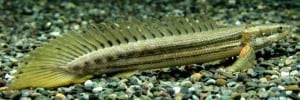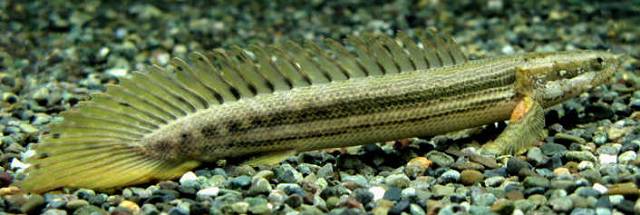
Common name: Nile Bichir
Scientific name: Polypterus Bichir Bichir
Average Adult Fish Size: 28 inches / 72 cm
Place of Origin: Africa
Typical Tank setup: A well decorated aquarium with well rooted and over hanging plants is appreciated as Bichirs are mainly nocturnal and do not like bright lighting. The base of the plants need to be protected by rockwork though, other wise a large bichir will eventually uproot and destroy them. Offer plenty of caves in the form of rockwork and bog/wood/driftwood along with medium to medium-fine sand or gravel as a substrate.
Recommended Minimum Aquarium Capacity: Juveniles can easily be kept in aquariums as small as a 20 gallon /80 litre, but full grown adults need an aquarium with large base dimensions measuring at least 6 feet x 2 feet / 180 cm x 60 cm , or 180 gallon / 720 litre. Depth is not as important as “floor space”.
Compatibility: All Bichirs are relatively peaceful with other fish that are too large too eat. They will eat others of their own kind given the chance though, so other Bichir tankmates should be close to the same size. Sometimes Bichirs will squabble among themselves over food, but rarely is any damage done.
Temperature: 77 – 83 Deg F / 26 – 28 Deg C
Water chemistry: pH 6.8 – 7.8
Feeding: Bichirs are carnivorous so feed meaty type foods consisting of good quality pellets of the appropriate size, sticks, chunks of frozen foods like brine shrimp, mysis shrimp, or beef heart along with chopped market shrimp, chunks of raw fish, blood worms, black worms, and earthworms.
Sexing: Males anal fin is larger and thicken than the females.
Breeding: Not recorded in captivity but is thought to breed in a similar way to other Polypterus species. The members of this genus breed during the rainy season in nature and changes in the temperature and chemistry of the water are likely to induce spawning behaviour. A large tank is required and should contain soft, slightly acidic water. It is an egg scatterer and therefore areas of dense planting and/or spawning mops should be provided. Courtship involves chasing and nudging of the female by the male. During spawning itself, the male receives the eggs from the female by cupping his anal and caudal fins around her genitals. He then fertilizes the eggs before scattering them amongst vegetation. At this point, the adult fish should be removed as they may predate upon the eggs. The eggs hatch in 3-4 days, with the fry becoming free swimming around 3 days later. First foods should be brine shrimp nauplii or microworm. Apparently the fry are not particularly mobile, so care should be exercised to ensure they are well fed.
Additional Information: Always make sure the aquarium is tightly covered with no open holes or means of escape. Bichirs are messy eaters, so provide good filtration and frequent partial water changes to maintain good water quality. Even though they are bottom dwellers, they must be able to surface when they feel like it. This is because they breathe oxygen from the air as well. Always ensure that your Bichir has enough room to go up for a fresh breath of air.


Related Posts
Croaking Gourami – Trichopsis vittatus
Benthochromis Tricoti
Large-eyed Mouthbrooder – Callochromis Macrops